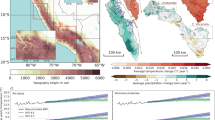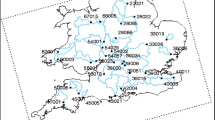Abstract
With down-scaled output from two General Circulation Models (the Geophysical Fluid Dynamics Laboratory, or GFDL, and the Parallel Climate Model, or PCM) and two emissions scenarios (A2 and B1), we project future trends in temperature and precipitation for the Tahoe basin. With the GFDL, we also project drought conditions and (through the use of a distributed hydrologic model) flood frequency. The steepest trend (GFDL with A2) indicates a 4–5°C warming by the end of the 21st century. Trends in annual precipitation are more modest with a dip in the latter half of the 21st century indicated by the GFDL/A2 case, but not the others. Comparisons with the Palmer Drought Severity Index show that drought will increase, in part due to the declining role of the snowpack as a reservoir for soil moisture replenishment. Analysis of flood frequency for the largest watershed in the basin indicates that the magnitude of the 100-yr flood could increase up to 2.5-fold for the middle third of the century, but decline thereafter as the climate warms and dries. These trends have major implications for the management of land and water resources in the Tahoe basin, as well as for design and maintenance of infrastructure.











Similar content being viewed by others
References
Alley W (1984) The Palmer drought severity index: limitations and assumptions. Jour Clim Appl Met 23:1100–1109
Barnett TP, Pierce DW, Hidalgo HG, Bonfils C, Santer BD, Das T, Bala G, Wood AW, Nozawa T, Mirin AA, Cayan DR, Dettinger MD (2008) human-induced changes in the hydrology of the Western United States. Science: 319(5866):1080–1083. doi:10.1126/science.1152538
Bicknell BR, Imhoff JC (1997) Hydrological simulation program—FORTRAN, User’s Manual for Version 11. Athens, GA, U.S. Environmental Protection Agency.
Cayan D, Tyree M, Dettinger M, Hidalgo H, Das T, Maurer E, Bromirski P, Graham N, Flick R (2009) Climate change scenarios and sea level rise estimates for the 2008 California climate change scenarios assessment. California Energy Commission, Sacramento, CA, p 62
Coats R (2010) Climate change in the Tahoe basin: regional trends, impacts and drivers. Clim Chang 102:435–466
Coats RN, Perez-Losada J, Schladow G, Richards R, Goldman CR (2006) The Warming of Lake Tahoe. Clim Chang 76:121–148
Costa-Cabral M, Coats R, Reuter J, Dettinger M, Maurer E, Miller N, Mills W, Riverson J, Roy S, Sahoo G, Schladow G, Wolfe B (2012) Climate variability and change in mountain environments: some implications for water resources and water quality in the Sierra Nevada. This issue.
Crawford NH, Linsley RK (1966) Digital Simulation in Hydrology, Stanford Watershed Model 4. California, Stanford University, Stanford
Dai A (2010) Drought under global warming: a review. Advanced Review. National Center for Atmospheric Research, Boulder CO. John Wiley & Sons, Ltd. doi:10.1002/wcc.81
Das T, Dettinger MD, Cayan DR, Hidalgo HG (2011) Potential increase in floods in California’s Sierra Nevada under future climate projections. Clim Chang. doi:10.1007/s10584-011-0298-z
Delworth TL, Broccoli AJ, Rosati A, Stouffer RJ, Balaji V, Beesley JA, Cooke WF, Dixon KW, Dunne J, Dunne KA, Durachta JW, Findell KL, Ginoux P, Gnanadesikan A, Gordon CT, Griffies SM, Gudgel R, Harrison MJ, Held IM, Hemler RS, Horowitz LW, Klein SA, Knutson TR, Kushner PJ, Langenhorst AR, Lee H-C, Lin S-J, Lu J, Malyshev SL, Milly PCD, Ramaswamy V, Russell J, Schwarzkopf MD, Shevliakova E, Sirutis JJ, Spelman MJ, Stern WF, Winton M, Wittenberg AT, Wyman B, Zeng F, Zhang R (2006) GFDL’s CM2 global coupled climate models - Part 1, Formulation and simulation characteristics. Jour Clim 19:643–674
Dettinger MD, Cayan DR, Knowles N, Westerling A, Tyree M (2004) Recent projections of 21st-century climate change and watershed responses in the Sierra Nevada. pp 43–46 USDA Forest Service Gen Tech Rep PSW-GTR-193
Dettinger M (2012) Projections and Downscaling of 21st Century Temperatures, Precipitation, Radiative Fluxes and Winds for the Southwestern US, with focus on the Lake Tahoe Basin. This issue
Dettinger MD, Cayan DR (1995) Large-scale atmospheric forcing of recent trends toward early snowmelt runoff in California. Jour Climate 8:606–623
Dobrowski SZ, Greenberg JA, Ustin SL (2005) Tahoe Basin Existing Vegetation Map v. 4.1 http://casil.ucdavis.edu/projects/tbevm
Flint LE, Flint AL (2012) Downscaling future climate scenarios to fine scales for hydrologic and ecological modeling and analysis. Ecological Processes 1:1. doi:10.1186/2192-1709-1-2
Hansen J, Sato M, Kharecha P, Beerling D, Masson-Delmotte V, Pagani M, Raymo M, Royer DL, Zachos JC (2009) Target atmospheric CO2: Where should humanity aim? Open Atmos. Sci Jour 2:217–231
Helsel DR, Frans LM (2006) Regional Kendall Test for Trend. Environ Sci Tech 40:4066–4073
Helsel DR, Hirsch RM (1995) Statistical Methods in Water Resources. Elsevier, New York
Helsel DR, Mueller DK, Slack JR (2005) Computer Program for the Kendall Family of Trend Tests. U.S. Geol. Surv, Reston, VA, p 4
Hidalgo HG, Dettinger MD, Cayan DR (2008) Downscaling with constructed analogues: Daily precipitation and temperature fields over the united states. California Climate Change Center, p. 48
IPCC (2007) Climate Change 2007, the Fourth Assessment Report (AR4) of the United Nations Intergovernmental Panel on Climate Change (IPCC)
Jassby AD, Reuter JE, Goldman CR (2003) Determining long-term water quality change in the presence of climatic variability, Lake Tahoe (USA). Can Jour Fish Aquat Sci 60:1452–1461
Johnson T, Dozier J, and Michaelsen J (1999) Climate change and Sierra Nevada snowpack. in Interactions Between the Cryosphere, Climate and Greenhouse Gases. Proc. IUGG 99 Symp. HS2, IAHS, Birmingham, pp. 63–70
Jeton AE (1999) Precipitation-Runoff Simulations for the Lake Tahoe Basin, California and Nevada. Water Resources Investigations WRI-99-4110 U.S. Geol. Surv., Carson City, NV, 61 p
Kothavala Z (1999) The duration and severity of drought over eastern Australia simulated by a coupled ocean–atmosphere GCM with a transient increase in CO2. Environ Modelling & Software 14:243–252
Manning MR, Edmonds J, Emori S, Grubler A, Hibbard K, Joos F, Kainuma M, Keeling RF, Kram T, Manning AC, Meinshausen M, Moss R, Nakicenovic N, Riahi K, Rose SK, Smith S, Swart R, van Vuure DP (2010) Misrepresentation of the IPCC CO2 emission scenarios. Letters, Nature Geosci, 3
Nakicenovic N, Alcamo J, Davis G, de Vries B, Fenhann J, Gaffin S, Gregory K, Grübler A, Yong Jung T, Kram T, Lebre La Rovere E, Michaelis L, Mori S, Morita T, Pepper W, Pitcher H, Price L, Riahi K, Roehrl A, Rogner H-H, Sankovski A, Schlesinger M, Shukla P, Smith S, Swart R, van Rooijen S, Victor N, Dadi Z (2000) Special report on emissions scenarios. Cambridge Univ. Press, Cambridge, UK
Null S, Viers J, Mount J (2010) Hydrologic response and watershed sensitivity to climate warming in California’s Sierra Nevada. PLoS One 5:e9932. doi:9910.1371/journal.pone.0009932
NRCS (2010) http://www.wcc.nrcs.usda.gov/snow/about.html
Palmer WC (1965) Meteorological drought. Climatology Research Papers, Washington, D.C., p 58
Piani C, Haerter JO, Coppla E (2010) Statistical bias correction for daily precipitation in regional climate models over Europe. Tehor Appl Climatol 99:187–192
Raupach MR, Marland G, Ciais P, LeQuere C, Canadell JG, Field CB (2007) Global and regional drivers of accelerating CO2 emissions. Proc Nat Academy Sci 104:10288–10293
Reuter JE, Cahill TA, Cliff SS, Goldman CR, Heyvaert AC, Jassby AD, Lindstrom S, Rizzo DM (2003) An integrated watershed approach to studying ecosystem health at Lake Tahoe, CA-NV. In: Lasley WL, Rolston DE, Nielsen NO, Qualset CO, Damania AB, Rapport DJ (eds) Managing for Healthy Ecosystems. Lewis Publishers, Boca Raton, FL, pp 1283–1298
Riverson J (2010) Projected flow nutrient and sediment loads based on climate change using output from the Lake Tahoe watershed model. The Effects of Climate Change on Lake Tahoe in the 21st Century, Meteorology, Hydrology, Loading and Lake Response. University of California, Davis, Tahoe Environmental Research Center and Department of Environmental Science & Policy. Davis, CA., Davis, CA, pp. 38–65
Riverson J, Costa-Cabral M, Coats R, Reuter J, Dettinger M, Sahoo G, Schladow G, Wolfe B (2012) Modeling the impacts of climate change on streamflow, nutrient and sediment loads in the Tahoe Basin. This issue
Rogers JH, United States Soil Conservation Service, United States Forest Service, California Agricultural Experiment Station, Max C. Fleischmann College of Agriculture Agricultural Experiment Station (1974) Soil survey, Tahoe Basin Area, California and Nevada. U.S. Soil Conservation Service and Forest Service, Portland, OR
Sahoo GB, Schladow SG, Reuter JE (2010) Effect of sediment and nutrient loading on Lake Tahoe optical conditions and restoration opportunities using a newly developed lake clarity model. Water Resour, Res, 46
Sahoo G, Schladow G, Reuter J, Coats R, Dettinger M, Riverson J, Wolfe B, Costa-Cabral M (2012) The impact of climate change on Lake Tahoe. This issue
Salmi T, Maatta A, Anttila P, Ruoho-Airola T, Amnell T (2002) Detecting trends of annual values of atmospheric pollutants by the Mann-Kendall test and Sen’s slope estimates–the Excel template application MAKESENS. Finnish Meteorological Institute, Helsinki, p 35
Simon A, Langendoen E, Bingner R, Wells R, Heins A, Jokay J, Jaramillo I (2003) Draft Final Lake Tahoe Basin Framework Implementation Study, Sediment Loadings and Channel Erosion. Channel and Watershed Processes Research Unit, National Sedimentation Laboratory. USDA Agric. Res. Serv. Oxford, Mississippi
Stewart IT, Cayan DR, Dettinger M (2005) Changes toward earlier streamflow timing across western North America. Jour Clim 18:1136–1155
Thornthwaite CW (1948) An approach toward a rational classification of climate. Geogr Rev 38:55–94
USGS (1981) Guidelines for determining flood flow frequency. Bulletin #17B of the Hydrology Subcommittee. U.S. Department of the Interior Geological Survey, Office of water data coordination, Reston, VA, p. 193. Available at: http://www.wou.edu/las/physci/taylor/hydro/g476w08.htm
USGS (2009) USGS Surface-Water Daily Statistics for California. http://waterdata.usgs.gov/ca/nwis/nwis
Washington WM, Weatherly JW, Meehl GA, Semtner AJ, Bettge TW, Craig AP, Strand WG, Arblaster JV, Wayland B, James R, Zhang Y (2000) Parallel climate model (PCM) control and transient simulations. Clim Dyn 16:755–774
Wells N, Goddard S, Hayes MJ (2004) A self-calibrating Palmer drought severity index. Jour Clim 17:2335–2351
Westerling AL, Hidalgo HG, Cayan DR, Swetnam T (2006) Warming and earlier spring increases western U.S. forest wildfire activity. Scienceexpress 10.1126/science.1128834:1–9
Wood AW, Leung LR, Sridhar V, Lettenmaier DP (2004) Hydrologic implications of dynamical and statistical approaches to downscaling climate model outputs. Clim Chang 62:189–216
Wood AW, Maurer EP, Kumar A, Lettenmaier DP (2002) Long-range experimental hydrologic forecasting for the eastern United States. J Geophys Res 107:4429. doi:4410.1029/2001JD000659
Zagona EA, Fulp TJ, Shane R, Magee T, Goranflo HM (2001) RiverWare: a generalized tool for complex river system modeling. Jour Am Water Resour Assoc 37(4):913–929
Zou GY, Donner A (2008) Construction of confidence limits about effect measures: A general approach. Statistics in Medicine 27:1693–1702
Acknowledgements
The Tahoe Climate Change Project was supported by grant #08-DG-11272170-101 from the USDA Forest Service Pacific Southwest Research Station using funds provided by the Bureau of Land Management through the sale of public lands as authorized by the Southern Nevada Public Land Management Act. We thank Jonathan Long for his patience and administrative help, and Jack Lewis for helpful suggestions.
Author information
Authors and Affiliations
Corresponding author
Additional information
This article is part of a Special Issue on Climate Change and Water Resources in the Sierra Nevada edited by Robert Coats, Iris Stewart, and Constance Millar.
Rights and permissions
About this article
Cite this article
Coats, R., Costa-Cabral, M., Riverson, J. et al. Projected 21st century trends in hydroclimatology of the Tahoe basin. Climatic Change 116, 51–69 (2013). https://doi.org/10.1007/s10584-012-0425-5
Received:
Accepted:
Published:
Issue Date:
DOI: https://doi.org/10.1007/s10584-012-0425-5




